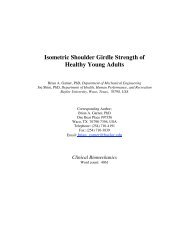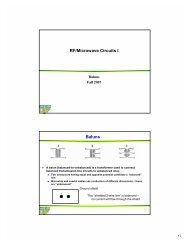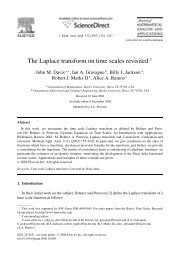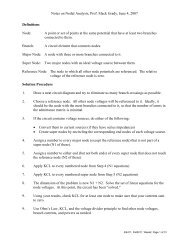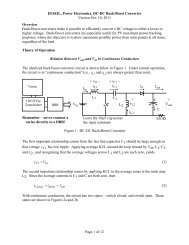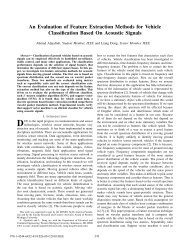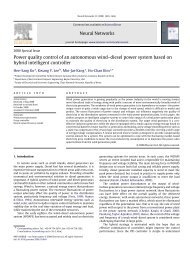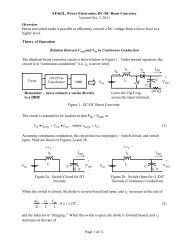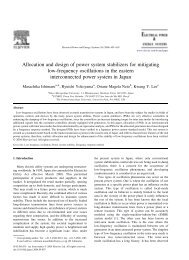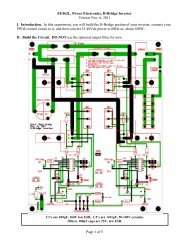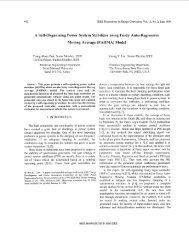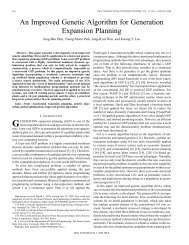Quantum Mechanics for Engineers - ECS - Baylor University
Quantum Mechanics for Engineers - ECS - Baylor University
Quantum Mechanics for Engineers - ECS - Baylor University
Create successful ePaper yourself
Turn your PDF publications into a flip-book with our unique Google optimized e-Paper software.
Outline<br />
What is Classical Physics?<br />
What is <strong>Quantum</strong> Physics?<br />
How Can This Apply to Computers?<br />
<strong>Quantum</strong> <strong>Mechanics</strong> <strong>for</strong> <strong>Engineers</strong><br />
Matt Robinson<br />
<strong>Baylor</strong> <strong>University</strong><br />
Department of Physics<br />
Matt Robinson<br />
<strong>Quantum</strong> <strong>Mechanics</strong> <strong>for</strong> <strong>Engineers</strong>
Outline<br />
What is Classical Physics?<br />
What is <strong>Quantum</strong> Physics?<br />
How Can This Apply to Computers?<br />
Matt Robinson<br />
<strong>Quantum</strong> <strong>Mechanics</strong> <strong>for</strong> <strong>Engineers</strong>
Outline<br />
Outline<br />
What is Classical Physics?<br />
What is <strong>Quantum</strong> Physics?<br />
How Can This Apply to Computers?<br />
1 What is Classical Physics?<br />
Matt Robinson<br />
<strong>Quantum</strong> <strong>Mechanics</strong> <strong>for</strong> <strong>Engineers</strong>
Outline<br />
Outline<br />
What is Classical Physics?<br />
What is <strong>Quantum</strong> Physics?<br />
How Can This Apply to Computers?<br />
1 What is Classical Physics?<br />
2 What is <strong>Quantum</strong> Physics?<br />
Matt Robinson<br />
<strong>Quantum</strong> <strong>Mechanics</strong> <strong>for</strong> <strong>Engineers</strong>
Outline<br />
Outline<br />
What is Classical Physics?<br />
What is <strong>Quantum</strong> Physics?<br />
How Can This Apply to Computers?<br />
1 What is Classical Physics?<br />
2 What is <strong>Quantum</strong> Physics?<br />
3 How Can This Apply to Computers?<br />
Matt Robinson<br />
<strong>Quantum</strong> <strong>Mechanics</strong> <strong>for</strong> <strong>Engineers</strong>
Outline<br />
What is Classical Physics?<br />
What is <strong>Quantum</strong> Physics?<br />
How Can This Apply to Computers?<br />
Actions and The Principle of Least Action<br />
Example<br />
Concluding Thoughts on Classical Physics<br />
Actions and The Principle of Least Action<br />
Knowing the (scalar) expressions <strong>for</strong> the kinetic energy T ( ˙q)<br />
and the potential energy V (q) <strong>for</strong> a system, we can define the<br />
Lagrangian as<br />
L(q, ˙q) ≡ T − V<br />
Matt Robinson<br />
<strong>Quantum</strong> <strong>Mechanics</strong> <strong>for</strong> <strong>Engineers</strong>
Outline<br />
What is Classical Physics?<br />
What is <strong>Quantum</strong> Physics?<br />
How Can This Apply to Computers?<br />
Actions and The Principle of Least Action<br />
Example<br />
Concluding Thoughts on Classical Physics<br />
Actions and The Principle of Least Action<br />
Knowing the (scalar) expressions <strong>for</strong> the kinetic energy T ( ˙q)<br />
and the potential energy V (q) <strong>for</strong> a system, we can define the<br />
Lagrangian as<br />
L(q, ˙q) ≡ T − V<br />
The Action S[q] is then defined as the integral over time,<br />
∫<br />
S[q] ≡ dt L(q, ˙q)<br />
Matt Robinson<br />
<strong>Quantum</strong> <strong>Mechanics</strong> <strong>for</strong> <strong>Engineers</strong>
Outline<br />
What is Classical Physics?<br />
What is <strong>Quantum</strong> Physics?<br />
How Can This Apply to Computers?<br />
Actions and The Principle of Least Action<br />
Example<br />
Concluding Thoughts on Classical Physics<br />
Actions and The Principle of Least Action<br />
The equations of motion are then given by the zeros of the<br />
Euler Lagrange Derivative,<br />
δL<br />
δq ≡ d ∂L<br />
dt ∂ ˙q − ∂L<br />
∂q = 0<br />
Matt Robinson<br />
<strong>Quantum</strong> <strong>Mechanics</strong> <strong>for</strong> <strong>Engineers</strong>
Outline<br />
What is Classical Physics?<br />
What is <strong>Quantum</strong> Physics?<br />
How Can This Apply to Computers?<br />
Actions and The Principle of Least Action<br />
Example<br />
Concluding Thoughts on Classical Physics<br />
Actions and The Principle of Least Action<br />
The equations of motion are then given by the zeros of the<br />
Euler Lagrange Derivative,<br />
δL<br />
δq ≡ d ∂L<br />
dt ∂ ˙q − ∂L<br />
∂q = 0<br />
This is called the principle of Least Action.<br />
Matt Robinson<br />
<strong>Quantum</strong> <strong>Mechanics</strong> <strong>for</strong> <strong>Engineers</strong>
Projectile Motion<br />
Outline<br />
What is Classical Physics?<br />
What is <strong>Quantum</strong> Physics?<br />
How Can This Apply to Computers?<br />
Actions and The Principle of Least Action<br />
Example<br />
Concluding Thoughts on Classical Physics<br />
T = 1 2 m(ẋ 2 + ẏ 2 ),<br />
V = mgy<br />
Matt Robinson<br />
<strong>Quantum</strong> <strong>Mechanics</strong> <strong>for</strong> <strong>Engineers</strong>
Projectile Motion<br />
Outline<br />
What is Classical Physics?<br />
What is <strong>Quantum</strong> Physics?<br />
How Can This Apply to Computers?<br />
Actions and The Principle of Least Action<br />
Example<br />
Concluding Thoughts on Classical Physics<br />
T = 1 2 m(ẋ 2 + ẏ 2 ),<br />
V = mgy<br />
L = T − V = 1 2 m(ẋ 2 + ẏ 2 ) − mgy<br />
Matt Robinson<br />
<strong>Quantum</strong> <strong>Mechanics</strong> <strong>for</strong> <strong>Engineers</strong>
Projectile Motion<br />
Outline<br />
What is Classical Physics?<br />
What is <strong>Quantum</strong> Physics?<br />
How Can This Apply to Computers?<br />
Actions and The Principle of Least Action<br />
Example<br />
Concluding Thoughts on Classical Physics<br />
T = 1 2 m(ẋ 2 + ẏ 2 ),<br />
V = mgy<br />
L = T − V = 1 2 m(ẋ 2 + ẏ 2 ) − mgy<br />
d ∂L<br />
dt ∂ẋ = d ∂L<br />
dt<br />
mẋ = mẍ,<br />
∂x = 0 ⇒ mẍ = 0<br />
Matt Robinson<br />
<strong>Quantum</strong> <strong>Mechanics</strong> <strong>for</strong> <strong>Engineers</strong>
Outline<br />
What is Classical Physics?<br />
What is <strong>Quantum</strong> Physics?<br />
How Can This Apply to Computers?<br />
Actions and The Principle of Least Action<br />
Example<br />
Concluding Thoughts on Classical Physics<br />
Projectile Motion<br />
T = 1 2 m(ẋ 2 + ẏ 2 ),<br />
V = mgy<br />
L = T − V = 1 2 m(ẋ 2 + ẏ 2 ) − mgy<br />
d ∂L<br />
dt ∂ẋ = d ∂L<br />
dt<br />
mẋ = mẍ,<br />
∂x = 0 ⇒ mẍ = 0<br />
d ∂L<br />
dt ∂ẏ = d ∂L<br />
dt<br />
mẏ = mÿ,<br />
∂y = −mg<br />
⇒ mÿ = −mg<br />
Matt Robinson<br />
<strong>Quantum</strong> <strong>Mechanics</strong> <strong>for</strong> <strong>Engineers</strong>
Outline<br />
What is Classical Physics?<br />
What is <strong>Quantum</strong> Physics?<br />
How Can This Apply to Computers?<br />
Actions and The Principle of Least Action<br />
Example<br />
Concluding Thoughts on Classical Physics<br />
Concluding Thoughts on Classical Physics<br />
Matt Robinson<br />
<strong>Quantum</strong> <strong>Mechanics</strong> <strong>for</strong> <strong>Engineers</strong>
Outline<br />
What is Classical Physics?<br />
What is <strong>Quantum</strong> Physics?<br />
How Can This Apply to Computers?<br />
Actions and The Principle of Least Action<br />
Example<br />
Concluding Thoughts on Classical Physics<br />
Concluding Thoughts on Classical Physics<br />
For a given initial condition,<br />
only one path is possible - the<br />
path which satisfies the<br />
Euler-Lagrange Equation.<br />
Matt Robinson<br />
<strong>Quantum</strong> <strong>Mechanics</strong> <strong>for</strong> <strong>Engineers</strong>
Outline<br />
What is Classical Physics?<br />
What is <strong>Quantum</strong> Physics?<br />
How Can This Apply to Computers?<br />
Actions and The Principle of Least Action<br />
Example<br />
Concluding Thoughts on Classical Physics<br />
Concluding Thoughts on Classical Physics<br />
For a given initial condition,<br />
only one path is possible - the<br />
path which satisfies the<br />
Euler-Lagrange Equation.<br />
Matt Robinson<br />
<strong>Quantum</strong> <strong>Mechanics</strong> <strong>for</strong> <strong>Engineers</strong>
Outline<br />
What is Classical Physics?<br />
What is <strong>Quantum</strong> Physics?<br />
How Can This Apply to Computers?<br />
Actions and The Principle of Least Action<br />
Example<br />
Concluding Thoughts on Classical Physics<br />
Concluding Thoughts on Classical Physics<br />
For a given initial condition,<br />
only one path is possible - the<br />
path which satisfies the<br />
Euler-Lagrange Equation.<br />
The nature of classical physics<br />
can be thought of as follows:<br />
INPUT: Ask question.<br />
OUTPUT: Get answer.<br />
Matt Robinson<br />
<strong>Quantum</strong> <strong>Mechanics</strong> <strong>for</strong> <strong>Engineers</strong>
Outline<br />
What is Classical Physics?<br />
What is <strong>Quantum</strong> Physics?<br />
How Can This Apply to Computers?<br />
Principle of Least Action . . . Probably<br />
Superposition<br />
So How Do We Do <strong>Quantum</strong> <strong>Mechanics</strong>?<br />
Observation<br />
Concluding Thoughts on <strong>Quantum</strong> Physics<br />
So What is <strong>Quantum</strong> Physics?<br />
Matt Robinson<br />
<strong>Quantum</strong> <strong>Mechanics</strong> <strong>for</strong> <strong>Engineers</strong>
Outline<br />
What is Classical Physics?<br />
What is <strong>Quantum</strong> Physics?<br />
How Can This Apply to Computers?<br />
Principle of Least Action . . . Probably<br />
Principle of Least Action . . . Probably<br />
Superposition<br />
So How Do We Do <strong>Quantum</strong> <strong>Mechanics</strong>?<br />
Observation<br />
Concluding Thoughts on <strong>Quantum</strong> Physics<br />
Matt Robinson<br />
<strong>Quantum</strong> <strong>Mechanics</strong> <strong>for</strong> <strong>Engineers</strong>
Outline<br />
What is Classical Physics?<br />
What is <strong>Quantum</strong> Physics?<br />
How Can This Apply to Computers?<br />
Principle of Least Action . . . Probably<br />
Principle of Least Action . . . Probably<br />
Superposition<br />
So How Do We Do <strong>Quantum</strong> <strong>Mechanics</strong>?<br />
Observation<br />
Concluding Thoughts on <strong>Quantum</strong> Physics<br />
Classical physics demanded<br />
δL<br />
δq = 0 Matt Robinson<br />
<strong>Quantum</strong> <strong>Mechanics</strong> <strong>for</strong> <strong>Engineers</strong>
Outline<br />
What is Classical Physics?<br />
What is <strong>Quantum</strong> Physics?<br />
How Can This Apply to Computers?<br />
Principle of Least Action . . . Probably<br />
Principle of Least Action . . . Probably<br />
Superposition<br />
So How Do We Do <strong>Quantum</strong> <strong>Mechanics</strong>?<br />
Observation<br />
Concluding Thoughts on <strong>Quantum</strong> Physics<br />
Classical physics demanded<br />
δL<br />
δq = 0 Matt Robinson<br />
<strong>Quantum</strong> <strong>Mechanics</strong> <strong>for</strong> <strong>Engineers</strong>
Outline<br />
What is Classical Physics?<br />
What is <strong>Quantum</strong> Physics?<br />
How Can This Apply to Computers?<br />
Principle of Least Action . . . Probably<br />
Principle of Least Action . . . Probably<br />
Superposition<br />
So How Do We Do <strong>Quantum</strong> <strong>Mechanics</strong>?<br />
Observation<br />
Concluding Thoughts on <strong>Quantum</strong> Physics<br />
Classical physics demanded<br />
δL<br />
δq = 0<br />
<strong>Quantum</strong> physics allows any<br />
value on the right hand side<br />
δL<br />
δq = λ<br />
where λ can be anything.<br />
Matt Robinson<br />
<strong>Quantum</strong> <strong>Mechanics</strong> <strong>for</strong> <strong>Engineers</strong>
Outline<br />
What is Classical Physics?<br />
What is <strong>Quantum</strong> Physics?<br />
How Can This Apply to Computers?<br />
Principle of Least Action . . . Probably<br />
Principle of Least Action . . . Probably<br />
Superposition<br />
So How Do We Do <strong>Quantum</strong> <strong>Mechanics</strong>?<br />
Observation<br />
Concluding Thoughts on <strong>Quantum</strong> Physics<br />
Classical physics demanded<br />
δL<br />
δq = 0<br />
<strong>Quantum</strong> physics allows any<br />
value on the right hand side<br />
δL<br />
δq = λ<br />
where λ can be anything.<br />
Matt Robinson<br />
<strong>Quantum</strong> <strong>Mechanics</strong> <strong>for</strong> <strong>Engineers</strong>
Outline<br />
What is Classical Physics?<br />
What is <strong>Quantum</strong> Physics?<br />
How Can This Apply to Computers?<br />
Principle of Least Action . . . Probably<br />
Principle of Least Action . . . Probably<br />
Superposition<br />
So How Do We Do <strong>Quantum</strong> <strong>Mechanics</strong>?<br />
Observation<br />
Concluding Thoughts on <strong>Quantum</strong> Physics<br />
Classical physics demanded<br />
δL<br />
δq = 0<br />
<strong>Quantum</strong> physics allows any<br />
value on the right hand side<br />
δL<br />
δq = λ<br />
where λ can be anything.<br />
Matt Robinson<br />
<strong>Quantum</strong> <strong>Mechanics</strong> <strong>for</strong> <strong>Engineers</strong>
Outline<br />
What is Classical Physics?<br />
What is <strong>Quantum</strong> Physics?<br />
How Can This Apply to Computers?<br />
Principle of Least Action . . . Probably<br />
Principle of Least Action . . . Probably<br />
Superposition<br />
So How Do We Do <strong>Quantum</strong> <strong>Mechanics</strong>?<br />
Observation<br />
Concluding Thoughts on <strong>Quantum</strong> Physics<br />
However, not all paths are equally probable.<br />
Matt Robinson<br />
<strong>Quantum</strong> <strong>Mechanics</strong> <strong>for</strong> <strong>Engineers</strong>
Outline<br />
What is Classical Physics?<br />
What is <strong>Quantum</strong> Physics?<br />
How Can This Apply to Computers?<br />
Principle of Least Action . . . Probably<br />
Principle of Least Action . . . Probably<br />
Superposition<br />
So How Do We Do <strong>Quantum</strong> <strong>Mechanics</strong>?<br />
Observation<br />
Concluding Thoughts on <strong>Quantum</strong> Physics<br />
However, not all paths are equally probable.<br />
Each possible path has a statistical weight/probability equal to<br />
e −S[q]/ or e iS[q]/<br />
(these are the same under the change of variables dt → idt)<br />
Matt Robinson<br />
<strong>Quantum</strong> <strong>Mechanics</strong> <strong>for</strong> <strong>Engineers</strong>
Outline<br />
What is Classical Physics?<br />
What is <strong>Quantum</strong> Physics?<br />
How Can This Apply to Computers?<br />
Principle of Least Action . . . Probably<br />
Superposition<br />
So How Do We Do <strong>Quantum</strong> <strong>Mechanics</strong>?<br />
Observation<br />
Concluding Thoughts on <strong>Quantum</strong> Physics<br />
But it gets worse<br />
Matt Robinson<br />
<strong>Quantum</strong> <strong>Mechanics</strong> <strong>for</strong> <strong>Engineers</strong>
Interference<br />
Outline<br />
What is Classical Physics?<br />
What is <strong>Quantum</strong> Physics?<br />
How Can This Apply to Computers?<br />
Principle of Least Action . . . Probably<br />
Superposition<br />
So How Do We Do <strong>Quantum</strong> <strong>Mechanics</strong>?<br />
Observation<br />
Concluding Thoughts on <strong>Quantum</strong> Physics<br />
q → e −S[q]/<br />
Matt Robinson<br />
<strong>Quantum</strong> <strong>Mechanics</strong> <strong>for</strong> <strong>Engineers</strong>
Interference<br />
Outline<br />
What is Classical Physics?<br />
What is <strong>Quantum</strong> Physics?<br />
How Can This Apply to Computers?<br />
Principle of Least Action . . . Probably<br />
Superposition<br />
So How Do We Do <strong>Quantum</strong> <strong>Mechanics</strong>?<br />
Observation<br />
Concluding Thoughts on <strong>Quantum</strong> Physics<br />
q → e −S[q]/<br />
q + δq → e −S[q+δq]/<br />
Matt Robinson<br />
<strong>Quantum</strong> <strong>Mechanics</strong> <strong>for</strong> <strong>Engineers</strong>
Interference<br />
Outline<br />
What is Classical Physics?<br />
What is <strong>Quantum</strong> Physics?<br />
How Can This Apply to Computers?<br />
Principle of Least Action . . . Probably<br />
Superposition<br />
So How Do We Do <strong>Quantum</strong> <strong>Mechanics</strong>?<br />
Observation<br />
Concluding Thoughts on <strong>Quantum</strong> Physics<br />
q → e −S[q]/<br />
q + δq → e −S[q+δq]/<br />
e −S[q+δq]/ = e<br />
δS[q]<br />
−(S[q]+δq δq )/ = e −S[q]/ e − δq δS[q]<br />
δq<br />
Matt Robinson<br />
<strong>Quantum</strong> <strong>Mechanics</strong> <strong>for</strong> <strong>Engineers</strong>
Interference<br />
Outline<br />
What is Classical Physics?<br />
What is <strong>Quantum</strong> Physics?<br />
How Can This Apply to Computers?<br />
Principle of Least Action . . . Probably<br />
Superposition<br />
So How Do We Do <strong>Quantum</strong> <strong>Mechanics</strong>?<br />
Observation<br />
Concluding Thoughts on <strong>Quantum</strong> Physics<br />
q → e −S[q]/<br />
q + δq → e −S[q+δq]/<br />
e −S[q+δq]/ = e<br />
Most likely path is where<br />
δS[q]<br />
−(S[q]+δq δq )/ = e −S[q]/ e − δq δS[q]<br />
δq<br />
δS[q]<br />
δq<br />
= 0<br />
(which is the same as where δL<br />
δq = 0)<br />
Matt Robinson<br />
<strong>Quantum</strong> <strong>Mechanics</strong> <strong>for</strong> <strong>Engineers</strong>
Equation of State<br />
Outline<br />
What is Classical Physics?<br />
What is <strong>Quantum</strong> Physics?<br />
How Can This Apply to Computers?<br />
Principle of Least Action . . . Probably<br />
Superposition<br />
So How Do We Do <strong>Quantum</strong> <strong>Mechanics</strong>?<br />
Observation<br />
Concluding Thoughts on <strong>Quantum</strong> Physics<br />
If ψ ∝ e iS/ , then<br />
∂ψ<br />
∂t = i ∂S<br />
∂t ψ<br />
Matt Robinson<br />
<strong>Quantum</strong> <strong>Mechanics</strong> <strong>for</strong> <strong>Engineers</strong>
Equation of State<br />
Outline<br />
What is Classical Physics?<br />
What is <strong>Quantum</strong> Physics?<br />
How Can This Apply to Computers?<br />
Principle of Least Action . . . Probably<br />
Superposition<br />
So How Do We Do <strong>Quantum</strong> <strong>Mechanics</strong>?<br />
Observation<br />
Concluding Thoughts on <strong>Quantum</strong> Physics<br />
If ψ ∝ e iS/ , then<br />
(where H ≡ T + V )<br />
∂ψ<br />
∂t = i ∂S<br />
∂t ψ<br />
Hψ = i ∂ψ<br />
∂t<br />
Matt Robinson<br />
<strong>Quantum</strong> <strong>Mechanics</strong> <strong>for</strong> <strong>Engineers</strong>
Equation of State<br />
Outline<br />
What is Classical Physics?<br />
What is <strong>Quantum</strong> Physics?<br />
How Can This Apply to Computers?<br />
Principle of Least Action . . . Probably<br />
Superposition<br />
So How Do We Do <strong>Quantum</strong> <strong>Mechanics</strong>?<br />
Observation<br />
Concluding Thoughts on <strong>Quantum</strong> Physics<br />
If ψ ∝ e iS/ , then<br />
∂ψ<br />
∂t = i ∂S<br />
∂t ψ<br />
Hψ = i ∂ψ<br />
∂t<br />
(where H ≡ T + V )<br />
Solving this differential equation (called Schroedinger’s Equation)<br />
<strong>for</strong> ψ will give the (complex) Wave Function <strong>for</strong> the particle<br />
Matt Robinson<br />
<strong>Quantum</strong> <strong>Mechanics</strong> <strong>for</strong> <strong>Engineers</strong>
Equation of State<br />
Outline<br />
What is Classical Physics?<br />
What is <strong>Quantum</strong> Physics?<br />
How Can This Apply to Computers?<br />
Principle of Least Action . . . Probably<br />
Superposition<br />
So How Do We Do <strong>Quantum</strong> <strong>Mechanics</strong>?<br />
Observation<br />
Concluding Thoughts on <strong>Quantum</strong> Physics<br />
If ψ ∝ e iS/ , then<br />
∂ψ<br />
∂t = i ∂S<br />
∂t ψ<br />
Hψ = i ∂ψ<br />
∂t<br />
(where H ≡ T + V )<br />
Solving this differential equation (called Schroedinger’s Equation)<br />
<strong>for</strong> ψ will give the (complex) Wave Function <strong>for</strong> the particle<br />
∫ b<br />
a<br />
ψ ⋆ ψ dx =<br />
∫ b<br />
a<br />
|ψ| 2 dx<br />
Matt Robinson<br />
<strong>Quantum</strong> <strong>Mechanics</strong> <strong>for</strong> <strong>Engineers</strong>
Outline<br />
What is Classical Physics?<br />
What is <strong>Quantum</strong> Physics?<br />
How Can This Apply to Computers?<br />
Principle of Least Action . . . Probably<br />
Superposition<br />
So How Do We Do <strong>Quantum</strong> <strong>Mechanics</strong>?<br />
Observation<br />
Concluding Thoughts on <strong>Quantum</strong> Physics<br />
Matt Robinson<br />
<strong>Quantum</strong> <strong>Mechanics</strong> <strong>for</strong> <strong>Engineers</strong>
Outline<br />
What is Classical Physics?<br />
What is <strong>Quantum</strong> Physics?<br />
How Can This Apply to Computers?<br />
Principle of Least Action . . . Probably<br />
Superposition<br />
So How Do We Do <strong>Quantum</strong> <strong>Mechanics</strong>?<br />
Observation<br />
Concluding Thoughts on <strong>Quantum</strong> Physics<br />
Matt Robinson<br />
<strong>Quantum</strong> <strong>Mechanics</strong> <strong>for</strong> <strong>Engineers</strong>
Outline<br />
What is Classical Physics?<br />
What is <strong>Quantum</strong> Physics?<br />
How Can This Apply to Computers?<br />
Principle of Least Action . . . Probably<br />
Superposition<br />
So How Do We Do <strong>Quantum</strong> <strong>Mechanics</strong>?<br />
Observation<br />
Concluding Thoughts on <strong>Quantum</strong> Physics<br />
Matt Robinson<br />
<strong>Quantum</strong> <strong>Mechanics</strong> <strong>for</strong> <strong>Engineers</strong>
Outline<br />
What is Classical Physics?<br />
What is <strong>Quantum</strong> Physics?<br />
How Can This Apply to Computers?<br />
Principle of Least Action . . . Probably<br />
Superposition<br />
So How Do We Do <strong>Quantum</strong> <strong>Mechanics</strong>?<br />
Observation<br />
Concluding Thoughts on <strong>Quantum</strong> Physics<br />
Matt Robinson<br />
<strong>Quantum</strong> <strong>Mechanics</strong> <strong>for</strong> <strong>Engineers</strong>
Hydrogen Atom<br />
Outline<br />
What is Classical Physics?<br />
What is <strong>Quantum</strong> Physics?<br />
How Can This Apply to Computers?<br />
Principle of Least Action . . . Probably<br />
Superposition<br />
So How Do We Do <strong>Quantum</strong> <strong>Mechanics</strong>?<br />
Observation<br />
Concluding Thoughts on <strong>Quantum</strong> Physics<br />
Matt Robinson<br />
<strong>Quantum</strong> <strong>Mechanics</strong> <strong>for</strong> <strong>Engineers</strong>
Hydrogen Atom<br />
Outline<br />
What is Classical Physics?<br />
What is <strong>Quantum</strong> Physics?<br />
How Can This Apply to Computers?<br />
Principle of Least Action . . . Probably<br />
Superposition<br />
So How Do We Do <strong>Quantum</strong> <strong>Mechanics</strong>?<br />
Observation<br />
Concluding Thoughts on <strong>Quantum</strong> Physics<br />
Matt Robinson<br />
<strong>Quantum</strong> <strong>Mechanics</strong> <strong>for</strong> <strong>Engineers</strong>
Observation<br />
Outline<br />
What is Classical Physics?<br />
What is <strong>Quantum</strong> Physics?<br />
How Can This Apply to Computers?<br />
Principle of Least Action . . . Probably<br />
Superposition<br />
So How Do We Do <strong>Quantum</strong> <strong>Mechanics</strong>?<br />
Observation<br />
Concluding Thoughts on <strong>Quantum</strong> Physics<br />
But it gets even worse ...<br />
Matt Robinson<br />
<strong>Quantum</strong> <strong>Mechanics</strong> <strong>for</strong> <strong>Engineers</strong>
Observation<br />
Outline<br />
What is Classical Physics?<br />
What is <strong>Quantum</strong> Physics?<br />
How Can This Apply to Computers?<br />
Principle of Least Action . . . Probably<br />
Superposition<br />
So How Do We Do <strong>Quantum</strong> <strong>Mechanics</strong>?<br />
Observation<br />
Concluding Thoughts on <strong>Quantum</strong> Physics<br />
A system exists in every possible state it can be in prior to<br />
observation (superposition).<br />
Matt Robinson<br />
<strong>Quantum</strong> <strong>Mechanics</strong> <strong>for</strong> <strong>Engineers</strong>
Observation<br />
Outline<br />
What is Classical Physics?<br />
What is <strong>Quantum</strong> Physics?<br />
How Can This Apply to Computers?<br />
Principle of Least Action . . . Probably<br />
Superposition<br />
So How Do We Do <strong>Quantum</strong> <strong>Mechanics</strong>?<br />
Observation<br />
Concluding Thoughts on <strong>Quantum</strong> Physics<br />
A system exists in every possible state it can be in prior to<br />
observation (superposition).<br />
These possibilities all interfere with each other.<br />
Matt Robinson<br />
<strong>Quantum</strong> <strong>Mechanics</strong> <strong>for</strong> <strong>Engineers</strong>
Observation<br />
Outline<br />
What is Classical Physics?<br />
What is <strong>Quantum</strong> Physics?<br />
How Can This Apply to Computers?<br />
Principle of Least Action . . . Probably<br />
Superposition<br />
So How Do We Do <strong>Quantum</strong> <strong>Mechanics</strong>?<br />
Observation<br />
Concluding Thoughts on <strong>Quantum</strong> Physics<br />
A system exists in every possible state it can be in prior to<br />
observation (superposition).<br />
These possibilities all interfere with each other.<br />
Once an observation is made, the system “collapses” into one<br />
of the possible states, according to some probability<br />
distribution which depends on the system.<br />
Matt Robinson<br />
<strong>Quantum</strong> <strong>Mechanics</strong> <strong>for</strong> <strong>Engineers</strong>
Outline<br />
What is Classical Physics?<br />
What is <strong>Quantum</strong> Physics?<br />
How Can This Apply to Computers?<br />
Principle of Least Action . . . Probably<br />
Superposition<br />
So How Do We Do <strong>Quantum</strong> <strong>Mechanics</strong>?<br />
Observation<br />
Concluding Thoughts on <strong>Quantum</strong> Physics<br />
Concluding Thoughts on <strong>Quantum</strong> Physics<br />
For a given initial condition, any path/state is possible - no<br />
matter how improbable it may be.<br />
Matt Robinson<br />
<strong>Quantum</strong> <strong>Mechanics</strong> <strong>for</strong> <strong>Engineers</strong>
Outline<br />
What is Classical Physics?<br />
What is <strong>Quantum</strong> Physics?<br />
How Can This Apply to Computers?<br />
Principle of Least Action . . . Probably<br />
Superposition<br />
So How Do We Do <strong>Quantum</strong> <strong>Mechanics</strong>?<br />
Observation<br />
Concluding Thoughts on <strong>Quantum</strong> Physics<br />
Concluding Thoughts on <strong>Quantum</strong> Physics<br />
For a given initial condition, any path/state is possible - no<br />
matter how improbable it may be.<br />
How often you will observe that path/state is determined by<br />
the wave function, which is a probability distribution.<br />
Matt Robinson<br />
<strong>Quantum</strong> <strong>Mechanics</strong> <strong>for</strong> <strong>Engineers</strong>
Outline<br />
What is Classical Physics?<br />
What is <strong>Quantum</strong> Physics?<br />
How Can This Apply to Computers?<br />
Principle of Least Action . . . Probably<br />
Superposition<br />
So How Do We Do <strong>Quantum</strong> <strong>Mechanics</strong>?<br />
Observation<br />
Concluding Thoughts on <strong>Quantum</strong> Physics<br />
Concluding Thoughts on <strong>Quantum</strong> Physics<br />
For a given initial condition, any path/state is possible - no<br />
matter how improbable it may be.<br />
How often you will observe that path/state is determined by<br />
the wave function, which is a probability distribution.<br />
The classical path/state will be the most likely, which is why<br />
macroscopic systems appear classical.<br />
Matt Robinson<br />
<strong>Quantum</strong> <strong>Mechanics</strong> <strong>for</strong> <strong>Engineers</strong>
Outline<br />
What is Classical Physics?<br />
What is <strong>Quantum</strong> Physics?<br />
How Can This Apply to Computers?<br />
Principle of Least Action . . . Probably<br />
Superposition<br />
So How Do We Do <strong>Quantum</strong> <strong>Mechanics</strong>?<br />
Observation<br />
Concluding Thoughts on <strong>Quantum</strong> Physics<br />
Concluding Thoughts on <strong>Quantum</strong> Physics<br />
For a given initial condition, any path/state is possible - no<br />
matter how improbable it may be.<br />
How often you will observe that path/state is determined by<br />
the wave function, which is a probability distribution.<br />
The classical path/state will be the most likely, which is why<br />
macroscopic systems appear classical.<br />
The nature of quantum physics can be thought of as follows:<br />
INPUT: Ask question, suggest an answer.<br />
OUTPUT: How often that answer will be right.<br />
Matt Robinson<br />
<strong>Quantum</strong> <strong>Mechanics</strong> <strong>for</strong> <strong>Engineers</strong>
Outline<br />
What is Classical Physics?<br />
What is <strong>Quantum</strong> Physics?<br />
How Can This Apply to Computers?<br />
Classical Bits and <strong>Quantum</strong> Bits<br />
Classical computer works using bits, which can either be 0 or 1<br />
Matt Robinson<br />
<strong>Quantum</strong> <strong>Mechanics</strong> <strong>for</strong> <strong>Engineers</strong>
Outline<br />
What is Classical Physics?<br />
What is <strong>Quantum</strong> Physics?<br />
How Can This Apply to Computers?<br />
Classical Bits and <strong>Quantum</strong> Bits<br />
Classical computer works using bits, which can either be 0 or 1<br />
A quantum computer uses quantum bits, which can be 0 and<br />
1<br />
|ψ〉 = α|0〉 + β|1〉<br />
Matt Robinson<br />
<strong>Quantum</strong> <strong>Mechanics</strong> <strong>for</strong> <strong>Engineers</strong>
Outline<br />
What is Classical Physics?<br />
What is <strong>Quantum</strong> Physics?<br />
How Can This Apply to Computers?<br />
Classical Bits and <strong>Quantum</strong> Bits<br />
Classical computer works using bits, which can either be 0 or 1<br />
A quantum computer uses quantum bits, which can be 0 and<br />
1<br />
|ψ〉 = α|0〉 + β|1〉<br />
Measurement produces:<br />
Matt Robinson<br />
<strong>Quantum</strong> <strong>Mechanics</strong> <strong>for</strong> <strong>Engineers</strong>
Outline<br />
What is Classical Physics?<br />
What is <strong>Quantum</strong> Physics?<br />
How Can This Apply to Computers?<br />
Classical Bits and <strong>Quantum</strong> Bits<br />
Classical computer works using bits, which can either be 0 or 1<br />
A quantum computer uses quantum bits, which can be 0 and<br />
1<br />
|ψ〉 = α|0〉 + β|1〉<br />
Measurement produces:<br />
0 with probability |α| 2<br />
Matt Robinson<br />
<strong>Quantum</strong> <strong>Mechanics</strong> <strong>for</strong> <strong>Engineers</strong>
Outline<br />
What is Classical Physics?<br />
What is <strong>Quantum</strong> Physics?<br />
How Can This Apply to Computers?<br />
Classical Bits and <strong>Quantum</strong> Bits<br />
Classical computer works using bits, which can either be 0 or 1<br />
A quantum computer uses quantum bits, which can be 0 and<br />
1<br />
|ψ〉 = α|0〉 + β|1〉<br />
Measurement produces:<br />
0 with probability |α| 2<br />
1 with probability |β| 2<br />
Matt Robinson<br />
<strong>Quantum</strong> <strong>Mechanics</strong> <strong>for</strong> <strong>Engineers</strong>
Outline<br />
What is Classical Physics?<br />
What is <strong>Quantum</strong> Physics?<br />
How Can This Apply to Computers?<br />
Manipulating Q-Bits<br />
Matt Robinson<br />
<strong>Quantum</strong> <strong>Mechanics</strong> <strong>for</strong> <strong>Engineers</strong>
Outline<br />
What is Classical Physics?<br />
What is <strong>Quantum</strong> Physics?<br />
How Can This Apply to Computers?<br />
Manipulating Q-Bits<br />
Any (invertible) trans<strong>for</strong>mation done to |ψ〉 will act on every<br />
term in the superposition:<br />
Matt Robinson<br />
<strong>Quantum</strong> <strong>Mechanics</strong> <strong>for</strong> <strong>Engineers</strong>
Outline<br />
What is Classical Physics?<br />
What is <strong>Quantum</strong> Physics?<br />
How Can This Apply to Computers?<br />
Manipulating Q-Bits<br />
Any (invertible) trans<strong>for</strong>mation done to |ψ〉 will act on every<br />
term in the superposition:<br />
NOT|ψ〉 = NOT(α|0〉 + β|1〉) = α|1〉 + β|0〉<br />
Matt Robinson<br />
<strong>Quantum</strong> <strong>Mechanics</strong> <strong>for</strong> <strong>Engineers</strong>
Outline<br />
What is Classical Physics?<br />
What is <strong>Quantum</strong> Physics?<br />
How Can This Apply to Computers?<br />
Manipulating Q-Bits<br />
Any (invertible) trans<strong>for</strong>mation done to |ψ〉 will act on every<br />
term in the superposition:<br />
NOT|ψ〉 = NOT(α|0〉 + β|1〉) = α|1〉 + β|0〉<br />
But, all operations done to a q-bit must be reversible<br />
Matt Robinson<br />
<strong>Quantum</strong> <strong>Mechanics</strong> <strong>for</strong> <strong>Engineers</strong>
Outline<br />
What is Classical Physics?<br />
What is <strong>Quantum</strong> Physics?<br />
How Can This Apply to Computers?<br />
Illustration of Why <strong>Quantum</strong> Computing Is So Powerful<br />
Matt Robinson<br />
<strong>Quantum</strong> <strong>Mechanics</strong> <strong>for</strong> <strong>Engineers</strong>
Outline<br />
What is Classical Physics?<br />
What is <strong>Quantum</strong> Physics?<br />
How Can This Apply to Computers?<br />
Illustration of Why <strong>Quantum</strong> Computing Is So Powerful<br />
Consider the Hadamard trans<strong>for</strong>mation H, which takes<br />
Matt Robinson<br />
<strong>Quantum</strong> <strong>Mechanics</strong> <strong>for</strong> <strong>Engineers</strong>
Outline<br />
What is Classical Physics?<br />
What is <strong>Quantum</strong> Physics?<br />
How Can This Apply to Computers?<br />
Illustration of Why <strong>Quantum</strong> Computing Is So Powerful<br />
Consider the Hadamard trans<strong>for</strong>mation H, which takes<br />
|0〉 → 1 √<br />
2<br />
(|0〉 + |1〉)<br />
Matt Robinson<br />
<strong>Quantum</strong> <strong>Mechanics</strong> <strong>for</strong> <strong>Engineers</strong>
Outline<br />
What is Classical Physics?<br />
What is <strong>Quantum</strong> Physics?<br />
How Can This Apply to Computers?<br />
Illustration of Why <strong>Quantum</strong> Computing Is So Powerful<br />
Consider the Hadamard trans<strong>for</strong>mation H, which takes<br />
|0〉 → 1 √<br />
2<br />
(|0〉 + |1〉)<br />
and<br />
|1〉 → 1 √<br />
2<br />
(|0〉 − |1〉)<br />
Matt Robinson<br />
<strong>Quantum</strong> <strong>Mechanics</strong> <strong>for</strong> <strong>Engineers</strong>
Outline<br />
What is Classical Physics?<br />
What is <strong>Quantum</strong> Physics?<br />
How Can This Apply to Computers?<br />
Illustration of Why <strong>Quantum</strong> Computing Is So Powerful<br />
Consider n copies of |0〉.<br />
Matt Robinson<br />
<strong>Quantum</strong> <strong>Mechanics</strong> <strong>for</strong> <strong>Engineers</strong>
Outline<br />
What is Classical Physics?<br />
What is <strong>Quantum</strong> Physics?<br />
How Can This Apply to Computers?<br />
Illustration of Why <strong>Quantum</strong> Computing Is So Powerful<br />
Consider n copies of |0〉.<br />
Act on each with H.<br />
Matt Robinson<br />
<strong>Quantum</strong> <strong>Mechanics</strong> <strong>for</strong> <strong>Engineers</strong>
Outline<br />
What is Classical Physics?<br />
What is <strong>Quantum</strong> Physics?<br />
How Can This Apply to Computers?<br />
Illustration of Why <strong>Quantum</strong> Computing Is So Powerful<br />
Consider n copies of |0〉.<br />
Act on each with H.<br />
Result is<br />
Matt Robinson<br />
<strong>Quantum</strong> <strong>Mechanics</strong> <strong>for</strong> <strong>Engineers</strong>
Outline<br />
What is Classical Physics?<br />
What is <strong>Quantum</strong> Physics?<br />
How Can This Apply to Computers?<br />
Illustration of Why <strong>Quantum</strong> Computing Is So Powerful<br />
Consider n copies of |0〉.<br />
Act on each with H.<br />
Result is<br />
1<br />
√<br />
2 n<br />
∑<br />
|j〉<br />
2 n<br />
j=1<br />
Matt Robinson<br />
<strong>Quantum</strong> <strong>Mechanics</strong> <strong>for</strong> <strong>Engineers</strong>
Outline<br />
What is Classical Physics?<br />
What is <strong>Quantum</strong> Physics?<br />
How Can This Apply to Computers?<br />
Illustration of Why <strong>Quantum</strong> Computing Is So Powerful<br />
Consider n = 3. Acting on three |0〉’s with H gives<br />
Matt Robinson<br />
<strong>Quantum</strong> <strong>Mechanics</strong> <strong>for</strong> <strong>Engineers</strong>
Outline<br />
What is Classical Physics?<br />
What is <strong>Quantum</strong> Physics?<br />
How Can This Apply to Computers?<br />
Illustration of Why <strong>Quantum</strong> Computing Is So Powerful<br />
Consider n = 3. Acting on three |0〉’s with H gives<br />
1<br />
√<br />
8<br />
(|0〉 + |1〉)(|0〉 + |1〉)(|0〉 + |1〉)<br />
Matt Robinson<br />
<strong>Quantum</strong> <strong>Mechanics</strong> <strong>for</strong> <strong>Engineers</strong>
Outline<br />
What is Classical Physics?<br />
What is <strong>Quantum</strong> Physics?<br />
How Can This Apply to Computers?<br />
Illustration of Why <strong>Quantum</strong> Computing Is So Powerful<br />
Consider n = 3. Acting on three |0〉’s with H gives<br />
1<br />
√<br />
8<br />
(|0〉 + |1〉)(|0〉 + |1〉)(|0〉 + |1〉)<br />
= 1 √<br />
8<br />
(<br />
|0〉|0〉|0〉 + |0〉|0〉|1〉 + |0〉|1〉|0〉 + · · · + |1〉|1〉|1〉<br />
)<br />
Matt Robinson<br />
<strong>Quantum</strong> <strong>Mechanics</strong> <strong>for</strong> <strong>Engineers</strong>
Outline<br />
What is Classical Physics?<br />
What is <strong>Quantum</strong> Physics?<br />
How Can This Apply to Computers?<br />
Illustration of Why <strong>Quantum</strong> Computing Is So Powerful<br />
Consider n = 3. Acting on three |0〉’s with H gives<br />
1<br />
√<br />
8<br />
(|0〉 + |1〉)(|0〉 + |1〉)(|0〉 + |1〉)<br />
= 1 √<br />
8<br />
(<br />
|0〉|0〉|0〉 + |0〉|0〉|1〉 + |0〉|1〉|0〉 + · · · + |1〉|1〉|1〉<br />
)<br />
So, any operation done to this state with n q-bits will produce<br />
a superposition of 2 n outcomes.<br />
Matt Robinson<br />
<strong>Quantum</strong> <strong>Mechanics</strong> <strong>for</strong> <strong>Engineers</strong>
Outline<br />
What is Classical Physics?<br />
What is <strong>Quantum</strong> Physics?<br />
How Can This Apply to Computers?<br />
Matt Robinson<br />
<strong>Quantum</strong> <strong>Mechanics</strong> <strong>for</strong> <strong>Engineers</strong>



